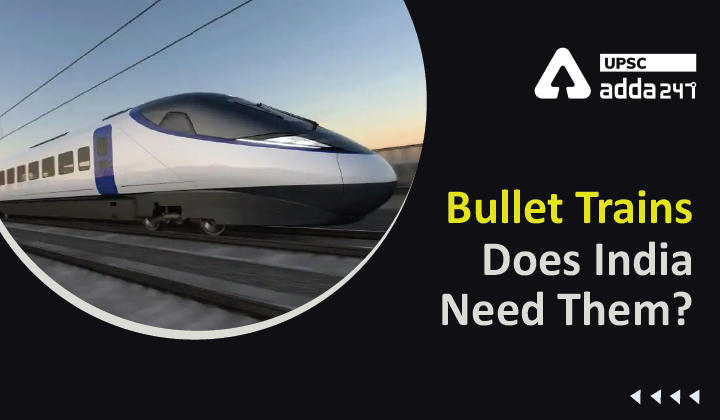Table of Contents
What are bullet trains?
- There is no standard definition of bullet trains or high-speed railways, but a railway system designed for speeds above 250kmph is often called high-speed railway.
- As of now, only 16 nations have high-speed railways.
- The first high-speed rail was inaugurated in 1964 in Japan between Tokyo and Osaka. It was given the name Shinkansen ‘bullet train’ (named for its shape), and could reach a speed of 210 kmph.
- In 1977, sections of the Florence-Rome line became Europe’s first high-speed railway at top speed of 250kmph.
Bullet trains in India
- India and Japan jointly laid the foundation stone of the Mumbai-Ahmedabad High Speed Rail (MAHSR) project, popularly known as the bullet train in 2017.
- Since the day of its proposal, the project is debated among the economists, experts, politicians, among others.
- The protagonists are of the opinion that this visionary project will herald a new era of safety, speed and service and help the Indian Railways craft a pathway to becoming a global leader in scale, technology and skill.
- The critics, on the other hand, are of the view that MAHSR is a vanity project which has little or no justification on the grounds of economic viability or public service.
Let’s analyse the benefits and challenges of bullet trains
Benefits of bullet train
- Speed: High speed is one of the primary reasons behind the proposal of bullet trains in India. Bullet trains would save time and boost businesses amongst the cities connecting with towns of economic growth. Example: Reduction in commuting time is required in Mumbai and other metro cities where a lot of time is consumed in transportation.
- Comfort: Bullet trains would utilize high grade technology, and hence provide comfortable journey of long hours within just a few hours. Comfort level is least issue under consideration for the railways. Coming of bullet trains would introduce this missing factor.
- Safety: Train safety has been one of the pioneer issues in the railway network, including the bullet trains. However, the arrival of Shinkansen network of Japan shows excellent records of safety. Ever since the bullet trains started in 1964, the Shinkansen has reported zero fatalities.
- Development and unemployment: The 12 bullet train stations would witness a new wave of development with increased employment opportunities. The stations would provide a platform for both the buyers and sellers of produces to enable transactions.
- Stronger and eco-friendly: Besides being stronger enough to carry heavier weight, bullet trains are also eco-friendly as they do not require deforestations to set tracks. It is a modern and technologically advanced means of transportation which can be a step towards growth and development in India.
- Cutting edge operational technology: India is getting cutting-edge operational technology in totality. The Shinkansen technology is renowned for its reliability and safety. The train delay record of Shinkansen is less than a minute with zero fatalities.
Challenges of bullet trains
- Cost of construction: The critics of the bullet trains raise questions about the economic viability of bullet trains. The cost of laying a bullet-train corridor is estimated to cost up to Rs 100 crore a kilometre. Moreover, after summing up the costs of signals, rolling stock, etc, the cost can rise up to Rs 115 crore a km. Similarly, operation and maintenance costs would also be high. All these costs raise a fundamental question that is India ready to bear such a high cost.
- High fares: Since the construction cost is high, fares of these trains would be high too. Example: One way fare on Mumbai-Ahmadabad route is projected to be around Rs 5,000. It is exorbitantly high considering the mass population of India. Given the income inequality in India, the project would only widen the rich-poor divide.
- Failed and struggling projects: Countries with HSR like South Korea, France, Taiwan are struggling with viability. Moreover, Argentina gave up on HSR ambitions on cost grounds, deciding instead to upgrade its entire railway system to medium-speed infrastructure.
- Land acquisition: It is one of the most challenging issue while dealing with any infrastructure projects, Delay in land acquisition leads to delay in project completion and it further leads to shooting up of project cost.
Bullet trains UPSC: Conclusion
- In India, we witnessed a new wave of development after coming up of metro rail. The Delhi Metro was constructed despite the questions being raised on its economic viability. Today, its success is second to none.
- Similarly, when the first Rajdhani was started, it was dubbed as ‘elitist’ and a luxury-driven initiative in a poor country. However, witnessing its success, it has been started for many routes.
- We should be careful not to confuse leapfrogging technology development with elitism — whether it is mobile phones, satellite launches, regional air-connectivity or high-speed rail.
- As far as the concept of bullet trains is concerned, it should be promoted. However, the challenges must be focussed upon to harness the true potential of bullet trains in India.
Read UPSC favourite topics





 TSPSC Group 1 Question Paper 2024, Downl...
TSPSC Group 1 Question Paper 2024, Downl...
 TSPSC Group 1 Answer key 2024 Out, Downl...
TSPSC Group 1 Answer key 2024 Out, Downl...
 UPSC Prelims 2024 Question Paper, Downlo...
UPSC Prelims 2024 Question Paper, Downlo...




